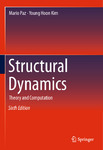| dc.description.abstract | The basic structure of the five previous editions is still maintained in this
Sixth Edition. After the release of the Fifth Edition in 2004, academic and
industrial environments have been changed, although the fundamentals have
not changed over 15 years. When the author started to teach structural
dynamics since 2011, the most challenging part as an instructor has been to
present how students can solve and simulate the structural dynamics using
the computer program. There is a limited information available to show how
we can solve structural dynamics in finite element method–based commercial
software. When understanding the background of undergraduate and
graduate students who are first exposed to structural dynamics, the
fundamentals are mainly considered as core content. The author believes
that a line-by-line computer language is a helpful learning and teaching tool
for its application of fundamentals. This is the major motivation of the
revision of this textbook.
This revised textbook intends to provide enhanced learning materials for
students to learn structural dynamics, ranging from basics to advanced topics,
including their application. When a line-by-line programming language is
included with solved problems, students can learn course materials easily and
visualize the solved problems using a program. Among several programming
languages, MATLAB® has been adopted by many academic institutions
across several disciplines. Many educators and students in the USA and
many international institutions can readily access MATLAB®, which has
an appropriate programming language to solve and simulate problems in the
textbook. It effectively allows matrix manipulations and plotting of data.
Therefore, multi-degree-of-freedom problems can be solved in conjunction
with the finite element method using MATLAB®. As of 2018, SAP2000
presented in the Fifth Edition is currently outdated, at least regarding user
interface procedure. The revision author Young Hoon Kim still believes that
SAP2000 includes routines for the analysis and design of structures with
linear or nonlinear behavior subjected to static or dynamics loads. However,
in this edition exclusion of SAP2000 is necessary to minimize the learner’s
confusion to link between contents and solving with the aid of computer
programming language. The author still believes that SAP2000 can be one of
the best tools to solve structural analysis and structural dynamics in complex
systems. Practical engineers who are eager to use commercial software can
learn from many other textbooks available in the market. | en_US |

